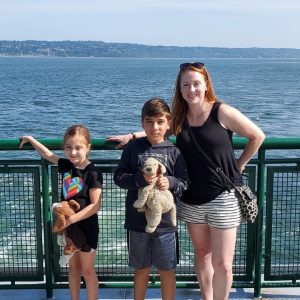My Kawasaki Disease Journey | 26 Years Post KD and Healthy!
Written by: Kate Davila
 My name is Kate Davila, and I had Kawasaki disease (KD) 26 years ago when I was 15 years old. I hope that my journey with this disease brings some comfort to your family. Even patients with heart complications can have healthy lives post KD.
My name is Kate Davila, and I had Kawasaki disease (KD) 26 years ago when I was 15 years old. I hope that my journey with this disease brings some comfort to your family. Even patients with heart complications can have healthy lives post KD.
I was diagnosed with KD on day 12 of the onset of symptoms. I received an IVIG treatment but was left with multiple giant-sized (8mm-11mm inches) aneurysms on my left and right coronary arteries. Since then, I have been on blood thinners (Warfarin) and beta-blockers, as well as cholesterol medications for preventative measures. I have also seen a cardiologist every year since I was 15 (initially it was twice a year, and now it’s annually). I have stress tests done every year. Currently, I’m alternating between regular stress tests and then nuclear stress tests every other year.
Immediately after returning to school post KD, I was not allowed to participate in gym class or sports. A year after my treatment, I was cleared for activities and was a runner and cheerleader while finishing out high school. In college, I continued to work out regularly at the gym. Still, at the age of 19 during my sophomore year of college, I suffered two mild heart attacks (non-damaging to my heart muscle). Both heart attacks happened within a few months of one another. My regular doctors at home understood my condition.
Nonetheless, medical professionals near my college did not believe that I was having pain in my arms and shortness of breath. Both times, my EKGs were normal, but when they tested my troponin levels, they both were elevated, showing that I indeed had a heart attack. Thankfully, I was treated and didn’t sustain damage to my heart and was able to return to school.
In 2006, my husband and I moved to the Seattle, WA, area, and I was able to connect with doctors from the University of Washington. At this point, we were thinking of starting a family and wanted to know if that would be possible considering the aneurysms. Fortunately, I was told that it wouldn’t be a problem for me to have a healthy pregnancy, as long as I was closely monitored. In 2009, I became pregnant with my son. I had to give myself Lovenox injections twice a day for blood thinning for the nine months, and my son was born on March 15, 2010, via c-section. After he was born, I ended up having internal bleeding issues related to the surgery that required secondary surgery and spending 12 days in the hospital. It was terrifying, but my doctors were 100% on top of things.
When my son was about five months old, I woke up with pain in my arms. Given my past experiences, I immediately went to the ER. My EKG was normal, but my troponin levels were elevated, and they determined I had another heart attack. This time, there was a small amount of damage to my heart muscle, but after my release, my doctors told me to continue with my active lifestyle and have no restrictions.
A few months later, I learned I was pregnant again. I contacted my physician right away and started my Lovenox injections, which continued until my daughter was born via c-section on January 28, 2012. After the birth, I had internal bleeding issues but was able to avoid a second surgery, and within a few days, my blood levels normalized.
I am now almost 42 years old, and I haven’t had any heart attacks or major issues in 9 years. I’ve maintained my active lifestyle, and five years ago became a fitness instructor. I try and do some activity every day, even if it’s just a long walk with my dog. I was told at my last stress test that my heart function is 60% better than the average person my age without heart conditions. My cardiologist has encouraged me to continue exercising and eating healthy.
Even though I will be on blood thinners and other heart medications for the rest of my life, I try to live my life with a positive attitude. Things may not look the way that I pictured them before KD, but it is my “normal.” My life consists of follow up appointments and stress tests with my cardiologists, parenting my kids, working out, eating as healthy as I can, and trying not to worry about the what-ifs.
As a parent myself, I understand fully how helpless my parents must have felt when I was diagnosed with KD all those years ago. I can understand the frustration many parents must feel when their child is diagnosed, and there is still so little known about KD. But I also know that it is so important to continue spreading awareness about KD so that a cause and diagnostic test can be created, and so children can get treated in a timelier manner. I hope that reading my story can help ease your minds to what the future might look like for any KD kids in your lives.
